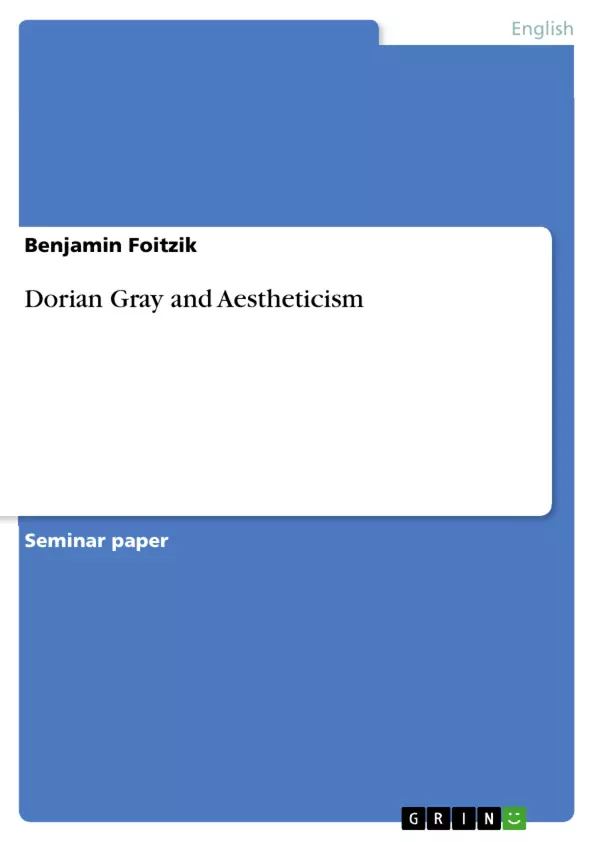In this paper I will first give an account of the aesthetic movement in England, from origin to decline, which I will then oppose to the character of Dorian Gray in Oscar Wilde′s The Picture of Dorian Gray. The comparison of the different stages in the development of both aestheticism and its incarnated representative Dorian Gray is intended to outline the fact that, even before the decline of aestheticism sets in in the 1890s, Oscar Wilde has anticipated the danger that lies in leading a life that is exclusively based on aesthetic values and pursuing its doctrines too persistently. Through the ruin of Dorian Gray, Wilde reveals the tragedy of the aesthetic movement and thus shows that it is eventually inevitably condemned to fail. Dorian is the epitome of an aesthete who in the end becomes the martyr of a movement which has preached, taught and understood its philosophy too narrow-mindedly. Of course this is a deficiency of narrow-mindedness in general and thus The Picture of Dorian Gray does not only represent the undoing of the epoch it was written in but also of any other theory or philosophy that takes itself too seriously.
I will support this statement with an assertion of Lord Henry Wootton′s, who is obviously a polemic on general principles but therefore mostly not less right.
"Humanity takes itself too seriously. It′s the world′s original sin. If the caveman had known how to laugh, History would have been different." (p.50 )1
Inhaltsverzeichnis (Table of Contents)
- I Introduction
- II What is Aestheticism? (two different philosophies)
- 1. Aestheticism as a philosophy of life
- 2. Aestheticism as a philosophy of art
- III The History of Aestheticism
- 1. The origin
- 2. The development
- 3. The decline
- IV The Development of Dorian Gray
- 1. The infection
- 2. The advanced stage
- 3. Transgression of the last frontier
- 4. The Fall of Dorian
- V The End
Zielsetzung und Themenschwerpunkte (Objectives and Key Themes)
This paper examines the aesthetic movement in England, tracing its development from its origins to its decline. It then analyzes the character of Dorian Gray in Oscar Wilde's The Picture of Dorian Gray, comparing the different stages of the aesthetic movement with Dorian's development. The goal is to demonstrate that Oscar Wilde, even before the decline of aestheticism in the 1890s, anticipated the dangers of leading a life solely based on aesthetic values and pursuing its doctrines too persistently. Through the downfall of Dorian Gray, Wilde reveals the tragedy of the aesthetic movement, ultimately showing its inevitable failure. Dorian embodies the aesthete who, in the end, becomes a martyr of a movement that has embraced its philosophy too narrowly.
- The aesthetic movement in England
- The philosophy of aestheticism as it relates to life and art
- The character of Dorian Gray as a representation of aestheticism
- The dangers of pursuing aesthetic values exclusively
- The inevitable failure of the aesthetic movement
Zusammenfassung der Kapitel (Chapter Summaries)
The first chapter introduces the paper and outlines its main objectives. It also explains the comparison between the aesthetic movement and Dorian Gray's character, highlighting the overarching theme of the dangers of narrow-mindedly embracing aesthetic philosophy.
The second chapter explores the concept of aestheticism through two different philosophies: aestheticism as a philosophy of life and aestheticism as a philosophy of art. The section on aestheticism as a philosophy of life examines the aesthetes' pursuit of beauty as a primary aim in life, their rejection of traditional Victorian values, and their emphasis on the enjoyment of beauty over other considerations. The section on aestheticism as a philosophy of art explores the concept of "Art for art's sake" and its separation of art from life.
The third chapter traces the history of the aesthetic movement, covering its origins, development, and decline.
The fourth chapter analyzes the development of Dorian Gray in the context of the aesthetic movement. This chapter examines Dorian's initial "infection" with aesthetic principles, his subsequent advancement in aesthetic ideology, his transgression of moral boundaries, and his ultimate fall.
Schlüsselwörter (Keywords)
Key terms and concepts include: Aestheticism, Victorian society, beauty, art for art's sake, philosophy of life, philosophy of art, Dorian Gray, Oscar Wilde, The Picture of Dorian Gray, Lord Henry Wootton, Walter Pater, New Hedonism, tragedy, narrow-mindedness.
- Quote paper
- Benjamin Foitzik (Author), 1999, Dorian Gray and Aestheticism, Munich, GRIN Verlag, https://www.grin.com/document/12126



